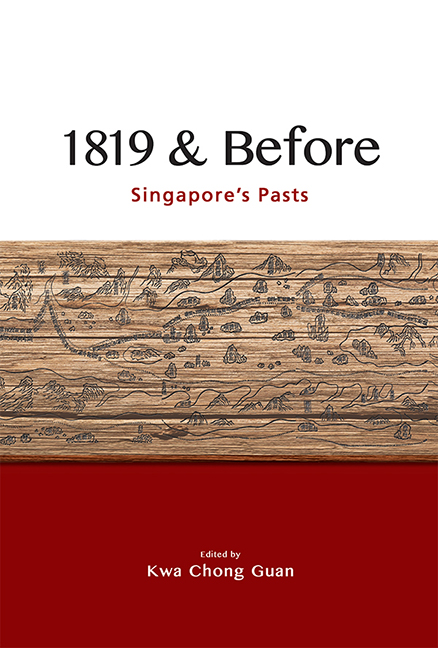Book contents
- Frontmatter
- Contents
- Foreword
- Acknowledgments
- Contributors
- 1 Introduction: Approaches to Singapore’s Past before 1819
- 2 Issues and Approaches to Studying Singapore before 1819
- 3 Regional Influences, International Geopolitics and Environmental Factors in the Rise and Demise of Temasek
- 4 The Mysterious Malay Jong and Other Temasek Shipping
- 5 The Orang Laut and the Negara Selat (Realm of the Straits)
- 6 Avoidance of Shipwreck in the Malay Annals: A Trope in Buddhist Narratives of Maritime Crossings
- 7 The Inception of Lion City
- 8 A Note on Amoghapāśa-Lokeśvara in Singapura
- 9 Portuguese and Dutch Records for Singapore before 1819: An Overview
- 10 Zheng He’s Navigation Methods and His Visit to Longyamen, Singapore
- Bibliography
- Index
5 - The Orang Laut and the Negara Selat (Realm of the Straits)
Published online by Cambridge University Press: 09 October 2021
- Frontmatter
- Contents
- Foreword
- Acknowledgments
- Contributors
- 1 Introduction: Approaches to Singapore’s Past before 1819
- 2 Issues and Approaches to Studying Singapore before 1819
- 3 Regional Influences, International Geopolitics and Environmental Factors in the Rise and Demise of Temasek
- 4 The Mysterious Malay Jong and Other Temasek Shipping
- 5 The Orang Laut and the Negara Selat (Realm of the Straits)
- 6 Avoidance of Shipwreck in the Malay Annals: A Trope in Buddhist Narratives of Maritime Crossings
- 7 The Inception of Lion City
- 8 A Note on Amoghapāśa-Lokeśvara in Singapura
- 9 Portuguese and Dutch Records for Singapore before 1819: An Overview
- 10 Zheng He’s Navigation Methods and His Visit to Longyamen, Singapore
- Bibliography
- Index
Summary
The Orang Laut played a significant role in the history of the Straits. This area is centred on the Straits of Melaka and the islands, the seas and the straits at the northern and southern entrances of the Straits and at the southernmost end of the South China Sea. This world or Realm of the Straits (Negara Selat) gained prominence because of the vibrant east–west international maritime trade between Europe, the Middle East, India and Sri Lanka in the west and China, Japan, Korea and the Ryukyu Islands in the east. Southeast Asia lay athwart this trading lane, with the Straits of Melaka being the only known passageway for centuries. Even after the Sunda Straits between Java and Sumatra came to be used increasingly after the sixteenth century, the Straits of Melaka continued to be the most travelled maritime route through Southeast Asia. The waters of the Straits were generally calm, and the mountain chains running along both spines of Sumatra and the Malay Peninsula provided all-year protection from the annual northeast and southwest monsoon winds. Before entering and leaving the southern end of the Straits of Melaka, ships had to cross a dangerous stretch of waters from the southeastern coast of Sumatra to Singapore, the Riau-Lingga Archipelagos and the islands and straits of the southern end of the South China Sea. For this reason, the entire area was considered to be a single maritime unit and came to be referred to simply as “the Sea” or “the Straits”.
In the Raffles MS 18 version of the Sulalatus-Salatin, more commonly known as the Sejarah Melayu or Malay Annals, the Malay word “Laut” or sea is the term used for this maritime space. When the Palembang lord Sri Tribuana decided to leave permanently to go abroad, he said to his minister: “I want to go to the Sea (Laut) to look for a good place so I can build a settlement (hendak berankgkat ke Laut, hendak mencari tempat yang baik hendak beta perbuatkan negeri).” Once he left Palembang he crossed over to the Sepat Straits and from the Sepat Straits to the Sambar Straits.
- Type
- Chapter
- Information
- 1819 & BeforeSingapore's Pasts, pp. 45 - 54Publisher: ISEAS–Yusof Ishak InstitutePrint publication year: 2021

